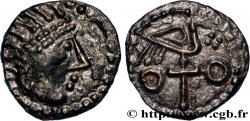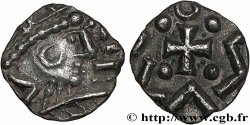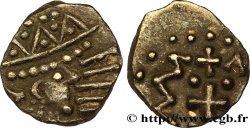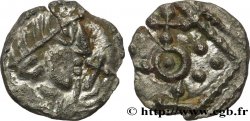Live auction - bmv_709061 - ENGLAND - ANGLO-SAXONS Sceat au porc-épic et à l’A croiseté
Чтобы принять участие в торгах, вы должны войти в систему и стать подтвержденным участником аукциона. Войдите, чтобы сделать ставку. Ваш аккаунт будет подтвержден в течение 48 часов. Не ждите до закрытия торгов, чтобы зарегистрироваться.Сделав ставку на данный товар, вы вступаете в юридическое соглашение на покупку выбранного товара и нажатием кнопки «Сделать ставку» подтверждаете принятие вами условий интернет-аукционов cgb.fr.
Ставка может бить сделана только в полном эквиваленте евро. Торги закроются согласно времени, указанному в описании товара, все ставки, сделанные после закрытия торгов, учитываться не будут. Не следует откладывать предложение вашей ставки до последнего момента, так как система может не успеть обработать вашу заявку, и ваша ставка не будет принята. Более детальную информацию вы найдёте здесь: FAQ по интернет-аукционам.
Все ставки победителей подлежат комиссии 18%.
Все ставки победителей подлежат комиссии 18%.
| Оценить : | 400 € |
| Цена : | Нет ставки |
| Максимальная предлагаемая цена : | Нет ставки |
| Конец торгов : | 25 January 2022 16:32:19 |
Тип Sceat au porc-épic et à l’A croiseté
Дата: c. 695-740
Монетный двор / Город: Atelier indéterminé
Металл: silver
Диаметр: 13,50 mm
Ориентация осей монеты: 3 h.
Вес: 1,09 g.
Редкость: R3
Комментарии о состоянии
Flan large et irrégulier mais bien centré. Patine tachée
Ссылки в каталоге: :
Лицевая сторона
Аверс: легенда: ANÉPIGRAPHE.
Аверс: описание: Tête très stylisée à droite, composée d’un croissant vertical et des mèches de cheveux hirsutes en arrière ; une croisette en guise de visage.
Обратная сторона
Реверс: легенда: ANÉPIGRAPHE.
Реверс: Описание: Grand A croiseté, entre deux croisettes.
Комментарий
S’il est possible de reconnaitre une extrême simplification de types plus traditionnels au droit, le revers présente un A croiseté. Si le A croiseté est assez largement représenté dans le monnayage mérovingien, il est très rare dans le monnayage anglo-saxon (notons cependant la monnaie W100 reproduite par T. Abramson avec un A croiseté décrit comme un monogramme de Marseille et considéré comme un denier “anglo-merovingien” de la série W).
S’agit-il d’une frappe mérovingienne s’inspirant d’un sceat. Faut-il rappeler que les sceat circulaient largement dans toute la Gaule ? Ou alors s’agit-il d’un sceat reprenant un type de revers typiquement mérovingien ?
Quoi qu’il en soit, ce denier ou sceat semble manquer à toutes les publications sur le sujet.
While it is possible to recognize an extreme simplification of more traditional types on the obverse, the reverse presents a crossed A. While the crossed A is quite widely represented in Merovingian coinage, it is very rare in Anglo-Saxon coinage (note, however, the W100 coin reproduced by T. Abramson with a crossed A described as a monogram of Marseille and considered an “Anglo-Merovingian” denarius from the W series). Is this a Merovingian strike inspired by a sceat? Should we recall that sceat circulated widely throughout Gaul? Or is it a sceat reproducing a typically Merovingian reverse type? In any case, this denarius or sceat seems to be missing from all publications on the subject
S’agit-il d’une frappe mérovingienne s’inspirant d’un sceat. Faut-il rappeler que les sceat circulaient largement dans toute la Gaule ? Ou alors s’agit-il d’un sceat reprenant un type de revers typiquement mérovingien ?
Quoi qu’il en soit, ce denier ou sceat semble manquer à toutes les publications sur le sujet.
While it is possible to recognize an extreme simplification of more traditional types on the obverse, the reverse presents a crossed A. While the crossed A is quite widely represented in Merovingian coinage, it is very rare in Anglo-Saxon coinage (note, however, the W100 coin reproduced by T. Abramson with a crossed A described as a monogram of Marseille and considered an “Anglo-Merovingian” denarius from the W series). Is this a Merovingian strike inspired by a sceat? Should we recall that sceat circulated widely throughout Gaul? Or is it a sceat reproducing a typically Merovingian reverse type? In any case, this denarius or sceat seems to be missing from all publications on the subject







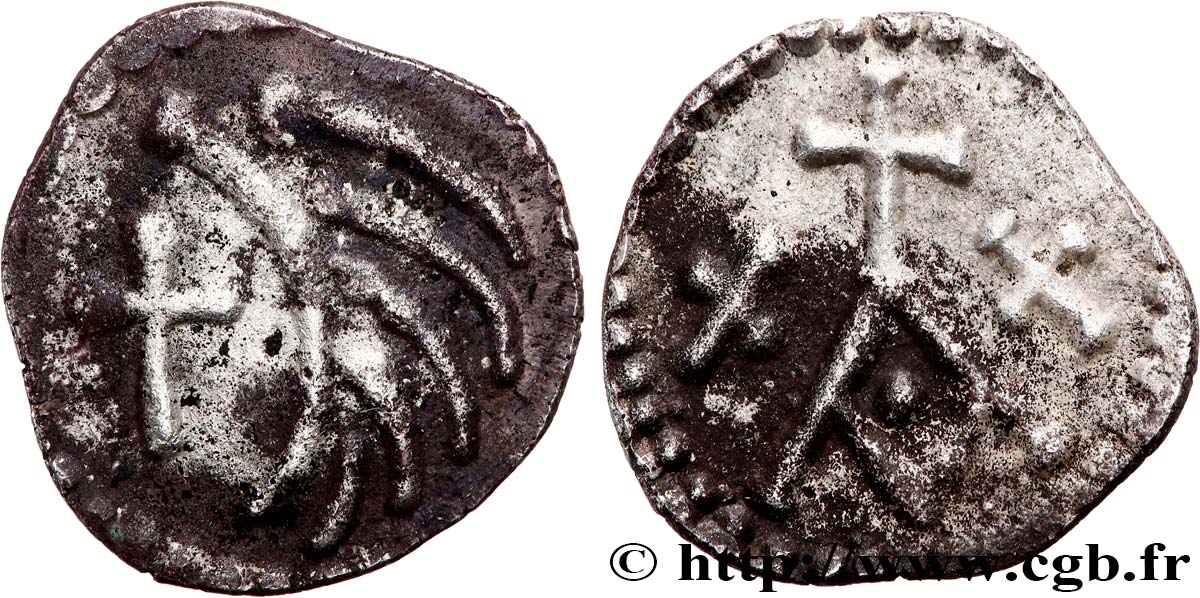
 Cообщить об ошибке
Cообщить об ошибке Распечатать страницу
Распечатать страницу Отправить мой выбор
Отправить мой выбор Задать вопрос
Задать вопрос Consign / sell
Consign / sell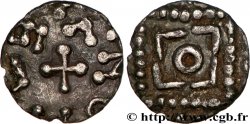
 Информация
Информация